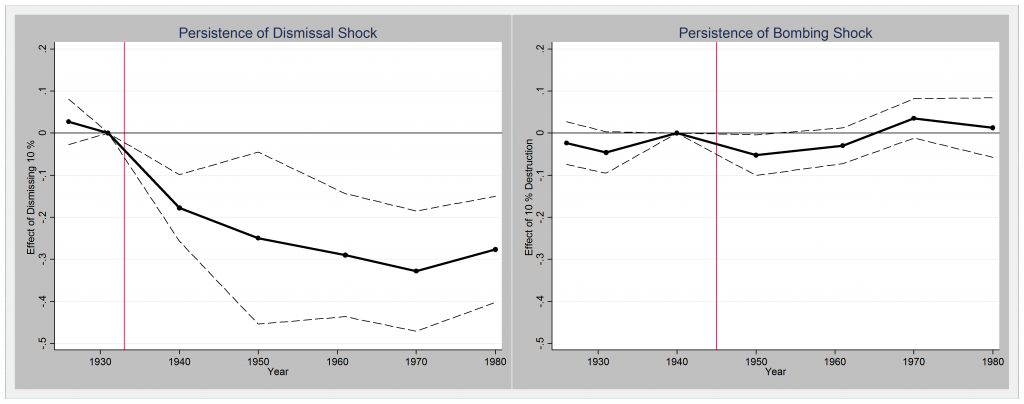 Which is more valuable to the creation of scientific knowledge, high quality scientists or first-class facilities? Fabian Waldinger looks at the dramatic effects of the Nazi expulsion of Jewish scientists and the Allied bombing of university buildings and discovers that brains had more impact than buildings.
Which is more valuable to the creation of scientific knowledge, high quality scientists or first-class facilities? Fabian Waldinger looks at the dramatic effects of the Nazi expulsion of Jewish scientists and the Allied bombing of university buildings and discovers that brains had more impact than buildings.
This article first appeared on the LSE Impact of Social Science blog
At the moment, many countries such as Brazil, South Korea, and especially China, are investing heavily in their university systems. Should they hire outstanding scholars or construct new laboratories to achieve the highest return on their investment? Similarly many other countries, such as the UK, are scrutinizing their expenditures for higher education. In which areas would spending cuts be less harmful?
Investigating these questions is challenging because “star scientists” like to work in more productive universities but at the same time they enhance the productivity of their university. Similarly, high quality universities attract more funding for laboratories and buildings which further increases productivity. As a result, it is difficult to evaluate how much high quality scientists and better facilities contribute to the creation of scientific knowledge.
My recent study investigates these questions by analysing a historical episode that affected German and Austrian universities in the 1930s and 1940s. In 1933, just two months after the Nazi government seized power, Jewish scientists and scientists with opposing political views were dismissed from the German (and later from Austrian) universities. Overall, about 15 percent of scientists had to leave their positions. Among the dismissed were some of the best scientists of the time, such as physics Nobel laureates Albert Einstein, Max Born, and Erwin Schrödinger and chemistry Nobel Prize winners Fritz Haber and Otto Meyerhof. Universities that had employed many Jewish scientists therefore suffered a tremendous decline in the number and quality of their faculty. Some years later, Allied bombings during the Second World War destroyed facilities of some universities while leaving the buildings of universities in other cities completely intact.
In my research I analyse how these temporary shocks affected German and Austrian universities both in the short and in the long run. To control for other factors that may have changed over time I compare universities with dismissals to universities without dismissals. Similarly, I compare universities with bombing destruction during the Second World War to universities without destruction. My findings indicate that the dismissal of 10 percent of the faculty reduced departmental productivity by about 0.21 standard deviations in the short run. Strikingly, departments that had lost people during the Nazi era still had lower scientific output almost 50 years later (see Figure 1, left hand panel).
The destruction of 10 percent of university buildings during the Allied bombing campaign lowered productivity by about 0.05 of a standard deviation in the short run; a reduction in productivity that was only about a quarter of the effect of the dismissal of 10 percent of the faculty. Furthermore the negative effect did not persist; by 1961, the productivity of departments that had been bombed during WWII had already recovered (see Figure 1, right hand panel).
Figure 1: The Long-Run Effects of Dismissals and Bombings
Note: The figure reports results for 10 percent dismissal and bombings shocks. The solid line indicates the effect of a 10 percent shock while the dashed lines indicate 95 percent confidence intervals.
Further results indicate that the loss in productivity was particularly large after the loss of high quality scientists. The loss of “star scientists” was especially detrimental. This shows that, at least for this historical period, brains were more important than buildings for the quality of research output. In recent decades scientific research has relied much more on expensive equipment, such as particle accelerators, and it is therefore not entirely clear how much these historical findings can inform current policy. Nonetheless they suggest that spending money on attracting high quality scientists may be money well spent if a university or country wanted to raise its research output.
This article summarizes the paper “Bombs, Brains, and Science: The Role of Human and Physical Capital for the Creation of Scientific Knowledge”. The full academic paper may be found here.
Note: This article gives the views of the author, and not the position of the British Politics and Policy blog, nor of the London School of Economics. Please read our comments policy before posting.






To control for other factors that may have changed over time I compare universities with dismissals to universities without dismissals.